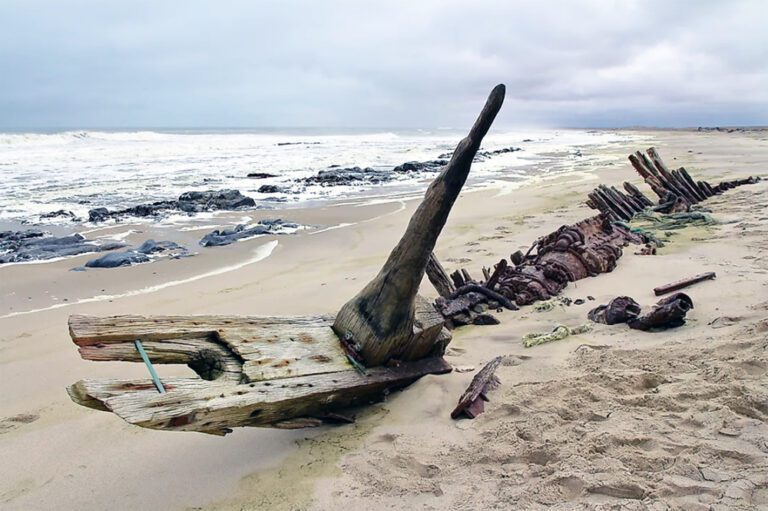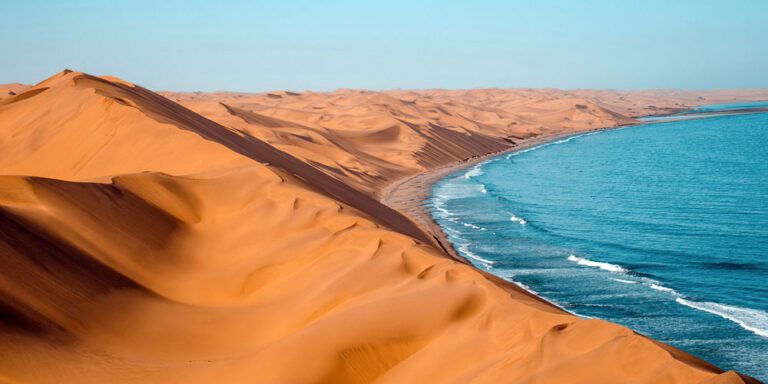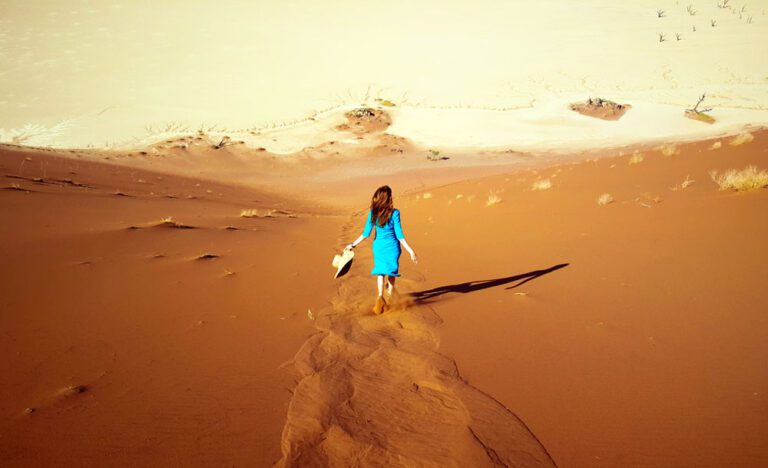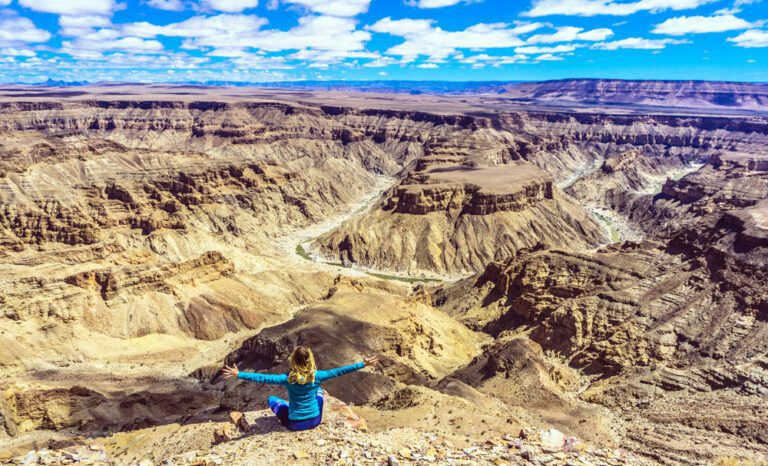Into the Unknown: Exploring the Namib Desert’s Hidden Wonders
Last updated on August 4th, 2023 at 08:33 pm

The Namib Desert is a large expanse of desert situated in the southwestern part of Africa. It stretches over 2000 kilometers from Angola to South Africa. It’s one of the oldest and driest deserts worldwide, receiving less than 10 millimeters of rain every year. Despite its tough conditions, it is home to various plants and animals that are unique and exciting and adapted to live there.
This article will tell you about some of the unknown gems of the Namib Desert, like the hidden oases, rare plants and animals, and interesting rocks. It will guide you to explore the undiscovered locations of the Namib Desert and reveal the secrets and mysteries they hold. If you like adventure or are curious about the world, this article will give you new ideas about the Namib Desert and inspire you to discover more.
Hidden Oases of the Namib Desert

Although the Namib Desert is famous for its barren, lifeless-looking terrain, it surprisingly houses several hidden oases that sustain an exceptional and varied range of plant and animal species. The oases are very important for the survival of both the desert environment and people who need them for water.
A few of these oases are famous, while others are not well-known, waiting for exploration. We will also highlight the unique features of these oases and their importance to the desert ecosystem and human survival.
Some of the lesser-known oases in the Namib Desert include:
Every oasis has its exceptional traits and features that are significant in sustaining life in the desert. The oases offer protection, water, and food for different types of animals, including tiny bugs and bigger animals like the elephants that adapted to living in the desert.
It’s essential to mention that these oases have been vital for the survival of human communities in the desert for thousands of years. The Himba, Herero, and San people have all adapted their lifestyles to the desert environment and rely on the oases for water and food.
Rare Flora and Fauna of the Namib Desert

The Namib Desert is a fantastic location with various captivating and exceptional plant and animal species that have adapted to survive in some of the most severe conditions on the planet. From enormous sand dunes to rocky mountains and vast plains, the desert is a challenging yet beautiful landscape that offers a glimpse into the resilience of life in even the most extreme environments.
Let’s explore some of the captivating and extraordinary flora and fauna species that survive in the Namib Desert their home. These species are important to the desert ecosystem. Understanding their adaptations and survival tactics can provide valuable insights into how life can flourish in such a challenging environment.
The Welwitschia plant is among the most well-known rare flora species in the Namib Desert. This plant is exclusive to the desert and can survive for over 2000 years. This plant has only two leaves that grow continuously throughout its life, and it survives on the moisture it extracts from the fog that rolls in from the Atlantic Ocean.
The desert-adapted elephants are one of the most unique and fascinating fauna species found in the Namib Desert. They changed over time to live with very little water and can travel long distances to find food and water. Other iconic species include the oryx, a large antelope with impressive horns that can withstand extreme temperatures, and the Namib sand gecko, which has evolved to blend in with the desert sand to avoid predators.
These unique and exceptional species remind us how adaptable and resilient life can be, even in the harshest environments on Earth. These species are vital for maintaining the delicate balance of the desert ecosystem and serve as an inspiration for us to keep challenging ourselves and reaching new limits.
Geological Wonders of the Namib Desert

The Namib Desert is a breathtaking and unique place, shaped by millions of years of geological forces. Let us discover the amazing geological wonders of the Namib Desert, such as the unique and stunning formations that make it a natural beauty.
One of the most iconic geological formations in the Namib Desert is the Spitzkoppe, a massive granite mountain that towers over the surrounding plains. It’s a popular destination for hikers and rock climbers and offers stunning views of the desert landscape. The Brandberg Mountains, the highest mountains in Namibia, are also home to unique flora and fauna. These mountains provide insight into the geological history of the region.
The Namib Desert also boasts unique geological phenomena such as “fairy circles,” circular patches of barren ground surrounded by rings of vegetation. The reason behind the fairy circles is unknown, but they are believed to result from several environmental factors, including the presence of termites living in the desert.
We can appreciate the Namib Desert’s natural beauty and complexity by understanding its geological forces. The desert’s foundation is made of ancient rocks. Ongoing forces of wind and water continue to shape its contours. The Namib Desert’s geology showcases the amazing power and wonder of nature.
Adventures in the Unknown: Exploring the Hidden Wonders

By exploring the lesser-known corners of the Namib Desert you will get a unique sense of adventure, freedom, and discovery that you cannot find in typical tourist destinations. By breaking away from the usual tourist routes, travelers can discover a more authentic side of the desert, and gain a deeper understanding of its complex ecosystem, history, and culture.
However, exploring the unknown in the Namib Desert can also be challenging and requires careful planning and preparation. You need to be careful and understand the difficulties of traveling in a desert. You should take the necessary steps to keep yourself safe and protect the desert ecosystem.
Some tips and recommendations for adventurous travelers seeking to explore the unknown in the Namib Desert include:
Discovering the hidden gems of the Namib Desert can be a transformative experience that connects one to nature and provides an enduring sense of adventure. You can discover a new side of the desert and develop a new perspective on your sense of adventure by exploring off the beaten path and embracing the unknown.
Conservation and Sustainability in the Namib Desert

The Namib Desert is a sensitive environment that requires protection to ensure that its hidden gems remain intact for future generations to appreciate. It is crucial to implement conservation measures to protect the desert’s unique plants, animals, and cultural heritage.
To conserve the Namib Desert, some conservation efforts are in place, such as the establishment of protected areas and the promotion of sustainable tourism practices. For instance, the Namib-Naukluft National Park is a large conservation area in Africa that is home to various endangered species, including black rhinos and Hartmann’s mountain zebras. The park also promotes sustainable tourism activities such as guided walks and nature drives that follow responsible tourism practices.
To minimize their impact on the desert ecosystem, visitors can adopt sustainable tourism practices. This includes using resources like water carefully, avoiding littering, and supporting eco-friendly accommodations and tour operators. Visitors should also respect the cultural heritage of the region and avoid disturbing historical sites or indigenous communities.
Conserving the Namib Desert and adopting sustainable tourism practices is essential to protecting its hidden wonders for future generations to explore and enjoy. By supporting conservation efforts and promoting responsible tourism practices, visitors can play a significant role in safeguarding this fragile and unique ecosystem.
Conclusion
We learned about the Namib Desert’s fascinating features. These include hidden oases, rare flora and fauna, and unique geological formations. We encourage readers to explore the desert’s lesser-known wonders to appreciate the ecosystem’s complexity and beauty better.
But it’s essential to approach this exploration responsibly by respecting the delicate balance of the desert ecosystem. Visitors can support conservation efforts and adopt sustainable tourism practices to help preserve Namib’s hidden wonders for future generations.
To sum up, we encourage readers to explore the Namib Desert, discover its hidden wonders, and gain a new perspective on nature and their sense of adventure. The desert has something to offer to everyone, and its hidden wonders are waiting to be explored.






